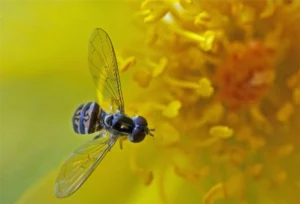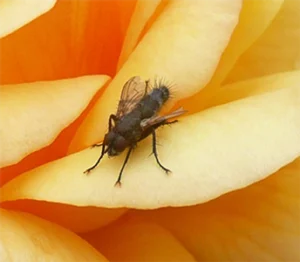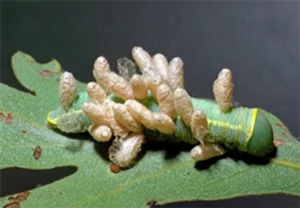by Nanette Londeree, Marin County Rose Society, Master Rosarian
Syrphid fly by Garrett Scales

The world is filled with insects – it’s estimated that there are more than a million different kinds. Most go about their daily business nearly invisible to us – pollinating plants, breaking down dead material and being served up as meals for birds, fish and other creatures. Some of them provide us gardeners with the invaluable service of keeping pest populations in check – the good bugs battling the bad ones.
Good bugs, also known as beneficial insects and natural enemies, are predators and parasites that control pests by eating them. Predators attack, kill and feed on their prey like the spider that ensnares the fly. Parasites are like the vampires of the insect world, seeking out victims for their blood or body fluids and living on (or in) their host. Most parasites, like fleas and mosquitos, are certainly not good bugs. However, the young version of some parasites, called parasitoids, are beneficial when they devour their host while they grow.
A predator will dispatch many individuals over the course of its life and is usually bigger than its prey. Parasitoids are much, much smaller than their prey, and have only one host in their lifetime. Parasitoids often complete their life cycle more quickly and increase their numbers much faster than many predators. They are so efficient at pest control that their cumulative impact often outweighs that of predators.
Your garden may be home to a variety of predatory insects. A familiar one, the lady bug, consumes many insects, especially aphids and other sap feeders. Their alligator-looking larvae is equally aggressive with an enormous appetite. Assassin bugs are black, brown or brightly-colored slender insects with an extended needle-like beak and enlarged bristly front legs. Ethereal-looking green lacewings have slender pale green bodies, delicate gossamer wings and immense golden eyes. Adults feed on pollen and nectar while their larvae are the predators. Minute pirate bugs are about the same to twice the size of an aphid. These fierce, generalist predators are somewhat oval shaped, black to purplish in color with a characteristic X-shape on their back. Soldier beetles are about one-half inch long, straight-sided with a red, orange, or yellow head and abdomen and prey on a wide range of bad bugs. Often referred to as flower or hover flies, syrphid flies resemble bees. The brightly colored adults are adorned with yellow banded abdomens and body markings. Again, it’s the larvae that are the predators while adults feast on pollen and nectar.

Types of wasps and tachinid flies are the most common parasitoid insects. The nearly invisible, non-stinging wasps with their trademark narrow wasp-waist, attack caterpillars, flies, true bugs and beetles. The immature forms do the damage, getting their nutrition by feeding in or on the body of another insect, while the mature forms are free-living and most often feed on pollen and nectar. Tachinid flies resemble houseflies and are covered with stiff hairs. They are endoparasitoids, developing inside their victims that include the larvae of moths, beetles, sawflies, stink bugs and other insects. ABOVE: Tachinid Fly by Nanette Londeree

To attract the good guys to inhabit your garden, provide them with food, water and shelter. Diverse plant types encourages a range of beneficials. Some favorites are members of the carrot family – dill, fennel and parsley; the daisy family – coneflowers, daisies and yarrow, and herbs like rosemary and thyme. Use local native flowering plants, trees, and shrubs to best meet the needs of local parasitoids. Include plants with different flowering times to provide nectar and pollen all season long. Avoid toxic chemicals and tolerate low populations of insect pests to ensure that food is available for the hungry garden helpers. ABOVE: Cocoons of a parasitoid wasp are attached to a caterpillar by UC ANR




























































